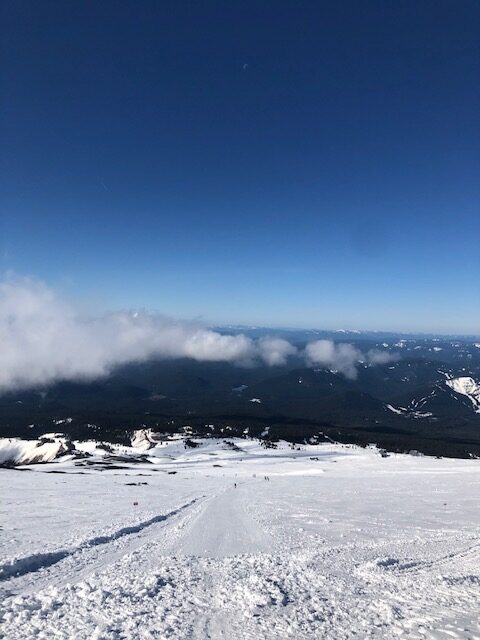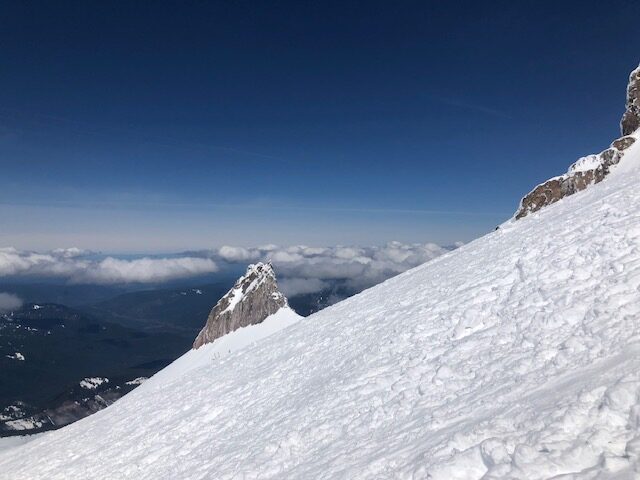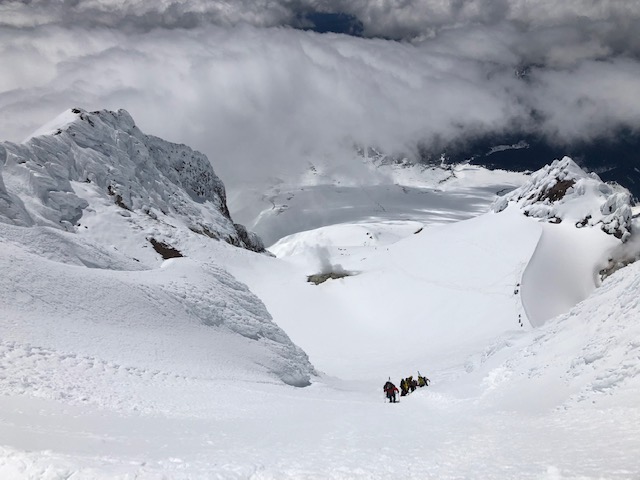Mt. Hood may be my favorite peak in the country. It’s the first Cascade peak I’ve summitted, and it has a very high gnarl to lack-of-accessibility ratio. Meaning, there is a lot of gnarl for how accessible it is. There is an incredible variety of terrain as well: Steep and broken glaciers, easy snow slopes, several-thousand-foot faces, long technical ice lines, and corniced rime-iced ridges jutting into the sky.
This would be my first time riding the peak, and I was excited. I haven’t been splitboarding long, and most of my alpine forays have been in boots so far. The efficiency of riding down what I used to clomp down was still novel.
There was a high-pressure system in the Pacific Northwest that weekend. The weather would be perfect. I picked the tried-and-true southern route for my first splitboard descent of the peak. I spent the night-before camping in a Sno-park lot a quarter-mile before the Timberline exit. My alarm was set for 6 a.m. When I woke, I brewed a cup of coffee, packed my backpack, and drove the 10 – 15 minutes to Timberline.
There was frost on my window, and my windshield wipers were worn. As I was driving, I sprayed my wiper fluid. A glossy film remained on my windshield which the wipers could not remove. I rounded an east-facing bend and the light of the sun reflected on the windshield. I was blind. I slammed on my brakes before I crashed through a guardrail and off a cliff. A few heart-pounding moments later, I resumed driving with my head sticking out the window. Goes to show that the most dangerous part of climbing is the drive!
I arrived at the climber’s lot, which was almost full. I found a parking spot, finished my packing, and carried my split-skis to the snowbank. It was 15 feet high. The snowpack was amazing compared to what it was last year. With 2021’s heat wave and drought, the region needed this.
I ran into a pair of skiers preparing to leave. They skinned up to Devil’s Kitchen Headwall intending to climb one of the ice lines. One of them forgot a part of their crampons so they had to ski down. Unfortunate, but they reassured me the snow wasn’t too bad. Or at least, not as bad as it could be on Mt. Hood.
I started skinning just after 7 a.m., glad to have gotten a “skier’s start.” I had the warmth of the sun upon me. When climbing the peak on foot I would need a before-sunrise start for more suitable snow — to allow easier step kicking and cramponing. On a splitboard, the softer snow on the ascent wouldn’t be a problem. On the descent, it would be bliss to ride down.
The first 2,400 feet of the ascent on this side of the peak is on a snow-cat track the ski resorts. I think they were tired of climbers swarming the resort boundaries. While the track was annoying for skinning traction, the grade is low for the first half and it wasn’t a problem. I zoomed up with easy gliding. Halfway up the grade steepened. I started to lose traction. I shifted off the cat-track and began skinning up more uniform snow.


Despite it being a blue-bird day, there were few skiers out. This is an hour from Portland, Ore., and you’re able to skin up alpine terrain right from the parking lot. It’s attractive to say the least. I heard that it’s because of Mt. Hood’s reputation for iciness, which I began to find out. Despite the force of the sun, the snow had an icy, chunky crust. My skins had trouble finding traction. I’m stubborn when it comes to finally putting on my crampons, but after three slip-and-slides looking like a clown to the skiers below me, I relented. I put on my split-ski crampons and crunched up with relative ease.
Suddenly overhead, a paraglider with skis on passed by, enjoying mid-air turns above the clouds. I’m not gonna lie, I was jealous. It’s one thing to ride down, but to fly down? That’s the pinnacle of descents. I want to learn how to paraglide one day, but that’s more gear I don’t have money or space for.

Past the top of the Palmer chairlift and approaching Crater Rock, the grade steepened even more. With the snow conditions, even my split-crampons began to lose traction. I persisted until a nice flat spot; which appeared to be the impromptu ski-shedding location of the day. I switched into boots and crampons. I stashed my skins and split-crampons between a patch of rime ice so it wouldn’t blow away. They would just be unnecessary weight on the way up, given the grade would continue to steepen. This was a mere 1,900 feet below the summit, and I was happy with being able to skin almost 2/3s of the elevation gain.

After transitioning to boots, it was between 9 and 10 a.m. I passed relatively few returning climbers going downhill. Most of my prior ascents on Mt. Hood were on weekdays when most people would be downhill by then. From here though, I got a great view of the remaining ascent route and received my answer. The Pearly Gates and Hogsback were bottle-necked with descending and ascending climbers. I knew on blue-bird weekend days the standard south side route is a dangerous mess, and here it was in full show. There were too many climbers on the same narrow route. If someone were to fall, they may end up sliding into a volcanic fumarole and dying of toxic gas inhalation — bringing other people down along the way. A great alternative if on foot and wanting to stick with the south side is the West Crater Rim route. That route is almost always empty. Being on a splitboard with a late start meant I’d avoid most of the mess thankfully.

A short time later, I reached the beginning of the Hogsback. Descending climbers were now passing by. I enjoyed some good conversation with a fellow splitboarder, who was camped on the Zig-Zag Glacier and planning to ride the Old Chute. I planned to ride the Old Chute as well, but despite the sun and the time, it remained chunky and icy. I could hear the occasional skier or rider descending well before I saw them. The scraping would resonate across the entire mountain. I took a snack break at the start of the Hogsback ridge and watched a skier in the Old Chute. She was gripped to the bone and remained motionless for 10 minutes, contemplating the position she was in. The fall-line of the Old Chute is into the fumaroles above Crater Rock: pits of rock and toxic gas. If you fall, it’s not going to end well. In the end, she managed to traverse over to the Hogsback and enjoyed better turns on the way down. I decided I’d leave the Old Chute for another day, and resolved to ride from the Hogsback below the Pearly Gates. I booted up the Hogsback, found a nice spot, and left my board 600 feet below the summit. That would leave me almost 5,000 feet of turns to enjoy.


I got to the Pearly Gates and they were clear. I was thankful there wasn’t a bottle-neck or any climbers to fall on me. It was a gorgeous palace of rime-ice with a narrow chute between the towers to the top, making it clear why they’re called the “Pearly Gates”.


It’s important to mention that I was using ultralight Petzl Leopard aluminum crampons. I bought these recently. The first time I used them was on the headwall of Tuckerman Ravine. I dealt with crampon issues there because I couldn’t figure out the dyneema-cord tightening system. Now that I figured it out, for some reason I decided that the Pearly Gates of Mt. Hood would be the perfect place to test them out again. The tiny aluminum points, along with the complete lack of rigidity in my splitboard boots and in the crampon, made them ineffective against the hard surface of the chute. They were constantly balling up too. There were shallow steps kicked in, but I didn’t have much of a front-point nor rigidity. They weren’t of much help. I had to slowly and methodically crawl my way up. Whatever time I saved with the lighter weight of these crampons was now lost. I got antiquated quickly with this new piece of gear however. Sometimes it takes being on the edge of sketch to garner the most knowledge. In hindsight, I would’ve brought a second axe or my steel crampons if I could’ve redone the ascent. These would be more effective with ski boots or full-shank mountaineering boots, which is what these crampons are more intended for.
After the Pearly Gates chute, 200 feet up the summit plateau brought me to the summit. I took a peek over the north side, and found the snowpack to be great. Much better than last year for sure. I saw clouds were coming from both the south and the north so I decided not to linger.

I didn’t want to downclimb the steeper Pearly Gates with these crampons. I decided to enter the lower-angle Old Chute. During the traverse on the summit ridge, a climber recognized me as being from the East thanks to my Cold Cold World pack. He was sporting one as well. It’s a great alpine climbing backpack made by a climber in a basement workshop in New Hampshire. This guy had climbed up the Reid Glacier Headwall route on the West Face of Mt. Hood but found it steep snow and not enough ice.
The various chutes leaving the summit ridge looked the same from above thanks to the sheer amount of rime, probably due to the stormy spring. I accidentally descended the chute one east over from the Old Chute. It might’ve been the 11-O’Clock Couloir or the Boy Scout Chute, but it was as steep as the Pearly Gates, with fewer steps this time. This once again got me very familiar with my crampons, but I made it down. I traversed to where I left my splitboard on the Hogsback, glad to be shedding the crampons and zooming down to my car. Unfortunately, clouds had moved in over Devil’s Kitchen and it was a white-out down below.


As I strapped in, the clouds swept away. I started descending with soft turns down the east side of the Hogsback, and then through Devil’s Kitchen. After Devil’s Kitchen though, the riding was rough, chunky and icy. Thanks, Mt. Hood. It was like trying to ride a mechanical bull, with the ground trying to buck you off balance. I’m no stranger to riding on ice, but I’m not going to lie, I ate it a few times trying to maintain an edge with my tired legs. I began wondering why I didn’t ride the softer snow on the Zig-Zag Glacier instead.
1,400 feet of descending later brought me to my stash point. I collected my skins and split-crampons, then resumed the descent. The ice was manageable now with the shallower grade, and I found some soft spring snow as well. Several thousand feet of turns later, I was back at the truck with a smile on my face, glad I wasn’t walking down.
